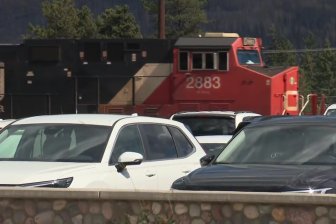CLEVELAND – When Donald Trump strides to the stage Thursday night to accept the presidential nomination of Abraham Lincoln’s political party, his address will borrow heavily from a more recent speech by another party nominee.

Richard Nixon – 1968.
The presumptive Republican nominee’s campaign manager said Monday that Trump studied past speeches while preparing his own, and was most captivated by the one Nixon delivered in a year with similar political overtones to this one.
READ MORE: Republicans paint picture of doom and gloom at home, clamour for Donald Trump
Back then the president-to-be promised law and order in a speech that referenced the country’s dual crises: race-related riots at home that left inner cities torched, and the bloody conflict abroad in Vietnam.
“As we look at America, we see cities enveloped in smoke and flames,” Nixon told delegates in Miami.
“We hear sirens in the night. We see Americans dying on distant battlefields abroad. We see Americans hating each other, fighting each other, killing each other at home. … Millions of Americans cry out in anguish, ‘Did we come all this way for this?”‘
These days the nation’s gloomy mood is reflected in polls showing race relations perceived to be at a low ebb. Outside schools, government buildings, and work sites flags seem perpetually at half-mast – the stars-and-stripes were lowered for the shootings of police in Dallas, and will remain so for Baton Rouge.
Day One of this year’s Republican convention focused on the familiar old themes of 1968: race-related unrest at home and bloodshed tied to conflicts abroad. It has been fuelled by police-related killings, and attacks such as the one in Nice France.

Get daily National news
Monday’s slogan was “Make America Safe Again.”
The speakers included tough-on-crime former New York mayor Rudy Giuliani and family members of people killed by illegal immigrants and at Benghazi, Libya. The mother of one Benghazi victim earned an ovation for declaring that Hillary Clinton belonged in prison.
One of the loudest cheers went to Milwaukee county sheriff David Clarke, an African-American and virulent critic of Black Lives Matter. Clarke has referred to the movement as “garbage” and suggested it might wind up aligning with ISIS.
WATCH: Trump releases 1st campaign video featuring running mate Pence

“Blue lives matter,” Clarke said, drawing a standing ovation. He earned another cheer for mentioning what he called good news: the latest not-guilty verdict in the death of Freddie Gray, whose spine was snapped after his arrest in Baltimore.
Trump has embraced the law-and-order theme.
“How many law enforcement and people have to die because of a lack of leadership in our country?” Trump wrote in a Facebook post Sunday, after the killing of three police officers in Louisiana.
“We demand law and order.”
A campaign adviser to Obama immediately spotted the historical parallel. David Axelrod tweeted in response to Trump’s Facebook post: “(He is) wasting no time. … Someone’s been studying Nixon ’68.”
Nixon capitalized on chaos at the Democratic convention, where anti-Vietnam war protesters were clubbed and tear gassed by police. Those events came just after African-American neighbourhoods had been torched in different cities, following the assassination of Martin Luther King.
READ MORE: Why one Trump supporter has a gun strapped to his leg during the Republican convention
Nixon responded by staging a campaign rally at the site of the convention – Chicago – where he promised change: “We’re going to have law and order.” His TV ads declared: “We have to rebuild respect for law in this country.”
There are obvious differences from those days.
As violent as terrorists have been, the number of American deaths is nowhere near the level of the Vietnam War, which took almost 17,000 lives in 1968. As for lawlessness in American streets, crime rates were steadily rising back then.
Now they’ve been mostly dropping for a generation. Law-and-order politics have fallen out of fashion. Partisans of different stripes, in Washington and at the state level, have turned their attention toward saving on prison costs and sparing families from the ripple effects of long term incarceration.
READ MORE: Donald Trump fails to bring Hollywood elite to Republican convention
But one critic of law-and-order politics notes a constant: the connection between tough-on-crime talk and race. In his book, “Dog Whistle Politics,” Ian Haney Lopez says the political theme goes right back to the end of slavery.
Nixon picked up on it to win votes from the segregationist George Wallace. His Alabama rival was once known for using overt racial slurs and paeans to racial separation, but over the course of the 1960s modified his language – he started railing against a general sense of lawlessness in the streets, which applied to everything from civil-rights marches to inner-city riots.
“Nixon had mastered Wallace’s dark art,” Haney Lopez wrote.
“Forced busing, law and order, and security from unrest as the essential civil right of the majority – all of these were coded phrases that allowed Nixon to appeal to racial fears without overtly mentioning race at all. Yet race remained the indisputable, intentional subtext.”
He pointed to later statements attributed to Nixon and an aide that the law-and-order theme was specifically designed to tap into white voters’ fears about minorities.












Comments